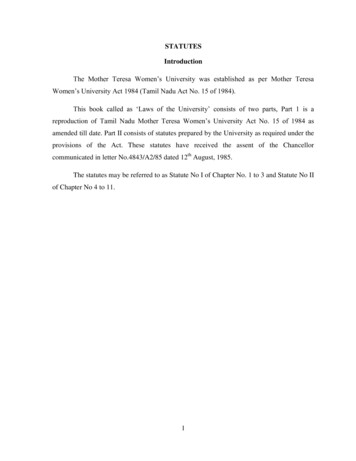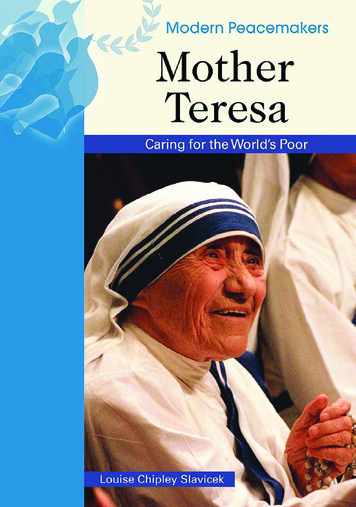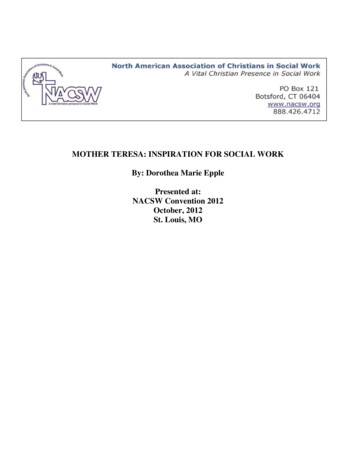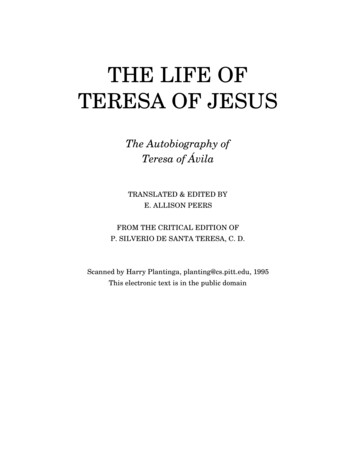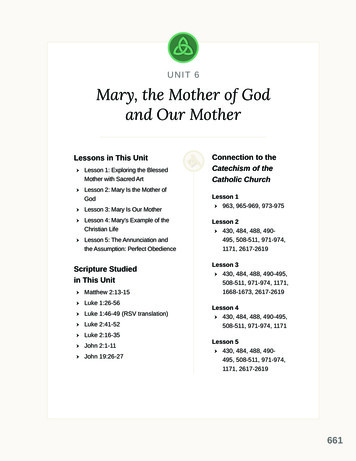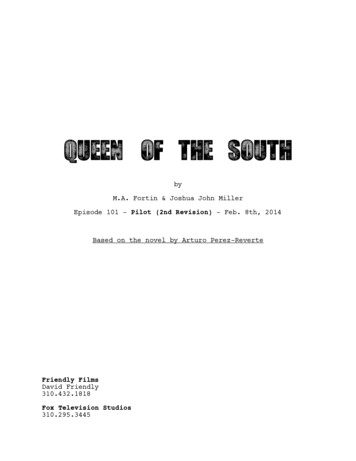
Transcription
Mother Teresa The Final VerdictBy Aroup ChatterjeeINTRODUCTIONMother Teresa once made me cry. The year was 1988 - I was on one of my frequent holidays orvisits to Calcutta from Britain, where I had moved to in 1985. I was standing by the kerb-side inGariahat Morr, munching on a famous 'mutton roll'. I was looking at scenes I had grown up with pavements almost obliterated by s hops, people having to weave their way through hawkerspeddling their fares; bus es tilted to one side by the sheer weight of passengers and belching outblack d iesel smoke, trams waiting for a manual change of tracks before they could turn, thefamiliar neon sign of an astrologer.In the midst of all this I remembered the 'Calcutta' of the West - Calcutta the metaphor, not thecity. In my three years in the West I had come to realise that the city had become synonymouswith the worst of human suffering and degradatio n in the eyes of the world. I read and heardagain and again that Calcutta conta ined an endless number of 'sewers and gutters' where anendless number of dead a nd dying people lay - but not for long - as 'roving angels' in the shape ofthe followers of a certain nun would come along looking for them.Then they would wh isk them away in their smart ambulances. As in my twenty-seven years inCalcutta I had never seen such a scene, (and neither have I met a Calcuttan who has), it hurt medeeply that such a wrong stereotype had become permanently ingrained in world psyche. I feltsuddenly overwhelmingly sad that a city, indeed an entire culture should be continuously insultedin this way. I am Calcuttan born and bred, and our family has lived in the city for as long a s can betraced. I know Calcutta well, and many people who matter there, and man y more who do not.I do not have Calcutta 'in my blood', but the place has defin itely made me what I am, warts andall. My mother tongue is Bengali, the languag e of Calcutta, but I speak Hindi passably, which isspoken by a large number of the destitutes of Calcutta. I had no interest whatsoever in MotherTeresa before I came to England. Difficul t it may seem to a Westerner to comprehend, but shewas not a significant entity in Calcutta in her lifetime; paradoxically posthumously her image hasrisen sig nificantly there - primarily because of the Indian need to emulate the West in m anyunimportant matters.I had had some interest in the destitutes of Calcutta during my college days, wh en I dabbled inleftist politics for a while. I also took a keen interest in hum an rights issues. Never in the course ofmy (modest) interaction with the very p oor of Calcutta, did I cross paths with Mother Teresa'sorganisation - indeed, I cannot ever recall her name being uttered. After living for some time in theWest, I (slowly) realised what Mother Teresa a nd Calcutta meant to the world.It shocked and saddened me. In India itself, to say you come from Calcutta is considered trendy, asCalcuttans are considered, w rongly, 'brainy and dangerous'. The Bombayite Gokhle is still widelyquoted, 'Wh at Bengal [Calcutta's state] thinks today, that India thinks tomorrow.' In India ,Calcutta is - not entirely wrongly - stereotyped as a seat of effete culture a nd anarchic politics.
There is an Indian saying that goes thus: 'If you have one Calcuttan you have a poet; with two youhave a political party, and with three you have two political parties.' The Calcutta stereotype in theWest did not irk me as much as did the firmly hel d notion that Mother Teresa had chosen to livethere as its saviour. I was aston ished that she had become a figure of speech, and that her namewas invoked to q ualify the extreme superlative of a positive kind; you can criticise God, but yo ucannot criticise Mother Teresa - in common parlance, doing the unthinkable is qualified as 'likecriticising Mother Teresa'.The number of times I have heard expressions such as 'So and so would try the patience of MotherTeresa', I have lost count. Such expressions would cause amazement and curiosity in Calcutta, even amongst Mother Teresa's most ardent admirers. Why I decided to do 'something about it' Icannot easily tell. As a person I am flawed enough to understand lies and deceit. Why certainpeople, themselves no p illars of rectitude, decide to make a stand against untruth and injustice isa v ery complex issue.Also, my wife, brought up (a Roman Catholic) in Ireland on Te resa mythology, felt angry andcheated when she went to Calcutta and saw how the reality compared with the fairy tale; she hasencouraged me in my endeavours. In February 1994, I rang, without any introduction, Vanya DelBorgo at the telev ision production company Bandung Productions in London. She listened to myangui shed outpourings and, to cut a long story short, eventually Channel 4 decided to undertakeHell's Angel (shown on Britain's Channel 4 television on 8 November 1 994), the very first attemptto challenge the Teresa myth on television.Ms Del Borgo chose Christopher Hitchens as the presenter, knowing him as she did from t heirdays together at The Nation in the United States. I am not happy with how H ell's Angel turnedout, especially its sensationalist approach, such as Mr Hitch ens's calling Mother Teresa 'apresumed virgin'.The film however caused some ri pple, in Britain and also internationally. Mother Teresa, onecould argue in her favour, is dead and therefore would be una ble to defend herself against mycharges. Criticisms of her however peaked durin g her lifetime; apart from the November 1994documentary, there was a stringent (and quite detailed) attack on conditions in her orphanages inIndia that was pu blished in The Guardian of London (14 October 1996) - charges of gross neglect and physical and emotional abuse were made. The article alleged her own complicit y andknowledge in the unacceptable practices that went (go) on in her homes.Du ring January 1997, a documentary - entitled Mother Teresa: Time for Change? - cr itical of herworking methods and accusing her of neglect, was shown on various European televisionchannels. It was up to Mother Teresa to have defended herself against such criticisms duri ng herlifetime. She did not. Her supporters (and others) would of course say th at she was like Jesus; thatshe would not demean herself by protesting against m uck raking - she would merely turn theother cheek.Notwithstanding her image, s he was a robust protester whenever she had a case. Shortly beforeshe died she g ot involved in legal wrangles with a Tennessee bakery over the marketing of a bu n;and more seriously, with her one time close friend and ally, the author Domin ique Lapierre, overthe script of a film on her life. On both occasions her Miami based solicitor got properly involved.
And then, the re is that well-known letter of protest she wrote to Judge Lance Ito protesting at theprosecution (she perceived it as persecution) of her friend Charles Keati ng, the biggest fraudsterin US history. After her death, her order continues with the litigious tradition - less than a yearafter her death it was involved in a court case with the Mother Teresa Memo rial Committee, aCalcutta based organisation.The German magazine Stern (10 September 1998) published a devastating critique o f MotherTeresa's work on the first anniversary of her death. The article, entit led 'Mother Teresa, WhereAre Your Millions?', which took a year's research in t hree continents, concluded that herorganisation is essentially a religious orde r that does not deserve to be called a charitablefoundation.No protest has bee n forthcoming from her order. To the charges of neglect of residents,indifference to suffering, massaging of figures, manipulation of the media and knowingly handlingmillions of dollars of stolen cash, Mother Teresa never protested. Her responses were 'Why didthey do it?', 'It was all for publicity.' She was perturbed by the criticisms - so much so that after the1994 documentary she cancelled a religious mission to the Far East.During her lifetime I wrote to Mother Teresa numerous times asking for a formal interview witheither her or one of her senior deputies. I had agreed to meet he r in Calcutta, or at the Vatican mindful her frequent trips there - or indeed, at any other place in the world. Despite her image carefully nurtured by her own self - of one who shunned the media and publicity, she had alwaysbent over backwards to give interviews to sympathetic world media (in other words, all theworld's media).In 1994 she spent a whole day talking to Hello! magazine; the s ame magazine ran a lengthyinterview with her successor in 1998. She however never even acknowledged any of my manyrequests for an interview. I had met her bri efly on occasions in the company of a roomful ofworshipful admirers, but I did not feel that was the time or the place to ask uncomfortablequestions.After two years of trying, when I failed to elicit any response from her or her order, I contacted herofficial biographers to ask whether they would answer som e of the serious question markshanging over her operations. All of them, bar on e, replied, but only to turn me down. All of thishappened while Mother Teresa w as alive. Many people tell me that Mother Teresa should be leftalone because she did 'som ething' for the underprivileged.I do not deny that she did. However her reputat ion, which was to a good extent carefully built upby herself, was not on a 'som ething' scale. More importantly, that 'something', at least inCalcutta, was qui te little, as my book will show. Even more importantly, she had turned awaymany many more than she had helped - although she had claimed throughout her life th at shewas doing everything for everybody. My brief against her is not that she did not address the rootor causes of suffering and I am not for a moment sugges ting that she ought to have done so, as Iunderstand the particular religious tr adition she came from - I am saying that there was astupendous discrepancy betw een her image and her work, between her words and her deeds;that she, helped by others of course, engaged in a culture of deception. On a superficial level, Ineed to tell the truth about Teresa because I feel hum iliated to be associated with a place that is
wrongly imagined to exist on Weste rn charity. Perhaps the main reason why I want to tell thisstory is because, I believe, each of us has a duty to stand up and protest when history is in dangerof being distorted. In a few years' time Mother Teresa will be up there, glitte ring in the samegalaxy as Mozart and Leonardo. I wish to convey my thanks to the some of the world's mostpowerful publishing f irms who put up obstacle after obstacle in the path of this book. Indeed, theBr itish arm of a multinational publishing house signed me up and then cancelled th e contractnine months later by sending me a half-page fax. My resolve to get th e book published grew allthe more stronger by such obstacles. I know I cannot change 'history' as pre-ordained by thepowerful world media, bu t I can attempt to put a footnote therein. I would disapprove of my bookbeing called 'controversial', as I see it as a boo k of hard facts, albeit disturbing sometimes.Calcutta has recently been renamed Kolkata by its rulers and a section of its ci tizens. The newname, which is politically correct and is closer to the vernacul ar pronunciation, has caught onfaster than expected. In this book, I have exclu sively used 'Calcutta', partly because to me itmakes more historical sense, and also because to tell the story of Mother Teresa, 'Calcutta' to meseems more ap propriate. Aroup Chatterjee London and Calcutta, 1996-2002 PREFACE by JoeWinter Calcutta has recently renamed itself Kolkata, in line with the Bengali pronuncia tion andwith a renaming in the case of two other Indian metropolises. The touch of colonialism, still feltafter its death, is shaken off a little by the gestu re, many would say, shrugged free of; but it is onlya gesture. The battle for i nternal independence for India is a deadlier business, the touch of thepast sti ll a dead weight, and a new nationalism beginning to take a very ugly form. Kolk ata'sacquiescence as a passive player in the charity charade, the part it conti nues to take in theMother Teresa phenomenon, makes a mockery of the symbol of s elf-determination in the changeof name. It is only too clear to a resident that the city is thrilled by the approaching sainthood. Itsvictimhood itself is to be canonised. It is a form of Western recognition, that elusive holy grail of the Indian psyche. By comparison, Asian recognition is a non-starter. It is in thi s perspective that DrChatterjee's illuminating analysis appears. Here are the h ard facts behind the phenomenon. Whatdid Mother Teresa really achieve? A lot less than she said, that much is clear. But does it do anyharm for her me
mory to be cherished, this indomitable old lady bent with devotion? Bengal has i ts saints Ramakrishna, Vivekananda, Rabindranath. Why not a woman too, in the capital of motherworship, the great spiritual home of the goddess Durga? Why no t indeed? - but in themarketplace of values to be set on display for the eyes o f later generations, let not an affinity forpurity, that so charges the popular mind, blind its gaze to the mixing-in of a baser metal. Therewas something won derful in Mother Teresa - and something not so wonderful. Princess Dianadied a few days before her, to an extraordinary if short-lived gl obal reaction. The world it seemsneeds fairy tales. The came the Mother's death and a myth was sealed. We need our myths tooand not only in literature; but wh ere there are facts to be stated alongside them they must surelybe stated. Ther e is a syndrome in the West's thinking about the less economically developed world; one might call it the sincerity syndrome. It relies on not looking too close ly at whatever mythsand legends are spun by those with a vested interest. How much 'conscience money' has beenpaid out, in the last hundred years, by the affluent in their blind sincerity, to what used to beknown as the Third World! Yet there is an alternative to misty-eyed shelling out, and it is not toturn o ne's back. First and foremost let us open our eyes. There is a story behind the popularversion of Mother Teresa's life - the story of facts - from which we can all learn. (Joe Winter is anEnglish poet who lives in Calcutta)CHAPTER 1'She rushes in to places where we would never go' On 11 October 1995, prostitutes in a certainquarter of Calcutta came out in for ce; they cajoled and coaxed passers-by for money, but not inreturn for the usua l favours. For some reason, they had decided to don white coats, the typeworn b y doctors, and they made a strange and surreal impact in the midst of the hectic Calcuttastreet. Each of them had a large collection tin in her hand, which was rattled vigorously as theladies walked along this congested street in north Ca lcutta. The sex workers were collectingmoney for flood victims. In September devastatin g floods had struck large areas of West Bengal,the state in India of which Calc utta is the capital. What made the floods especially poignant wasits timing - i t had come just before the biggest festival of 70 million Indian Bengalis, the spectacular Durga Pujo. Although in Indian terms, the number of casualties was sm all, with 200dead (many of them from snake bites, as is often the case during f loods, when snakes andhumans climb up to the same elevation), more than three m illion people were made homeless inthe villages surrounding Calcutta. In pure f inancial terms, the loss was estimated at Rs 1050million. The stories of loss and suffering moved millions, including the sex workers. One of them,Uma Mandal, said to newspapermen, 'How can we call ourselves human if we don't come to theaid of suffering people in their hour of need? Those who ha ve lost everything in the floods couldeasily be the members of our own families .' Sankari Pal, who could not read or write, but hadcome to know of the devasta tion through television, said, 'Although I don't personally knowanybody who has been affected by the floods, we believe we are very much part of a widercommun ity, and so, it was almost natural for us to come out to help.'1 The sex workers' collectiondrive was jointly organised by the Institute of Heal th and Hygiene, the Women's Co-ordinationCommittee and a neighbourhood club, th e Ward no. 48 Milan Sangha. This was merely one of themany hundreds of collecti on drives and relief measures organised by the citizens of Calcutta,operations that started in September and that lasted almost six months. Schools, colleges, offices,businesses, restaurants and individuals all chipped in. The only organi sation that did not feature
was the Missionaries of Charity, the multinational c harity headed by Mother Teresa, the personwho has become synonymous with Calcut ta in the eyes of the world. Mother Teresa's absence inthe relief operations wa s not conspicuous in Calcutta. Strange though it may seem to a nonCalcuttan, he r order is not known to throw in its lot in these circumstances. In Calcutta, sh e wasknown to undertake small niche activities, for which she was generally lik
ed and her order is well regarded. When the floods were raging in and around Calcutta, MotherTeresa was, like she would be during any summer and monsoon, in the United States. On 15 June1995 sh e was touring the neonatal unit at St Elizabeth's Medical Centre in Brighton, Massachusetts. Parents could not believe their luck when she left the babies (many of thempremature) her blessings and her hallmark, an oval aluminium 'miraculou s' medal. She told themedia, 'I have 200 small babies in my hospital in Calcutt a. This is a beautiful place.' 2 She howeverdoes not have any hospitals in Calc utta, nor for that matter anywhere else in the world. DennisMcHugh, father of H ayley born 25 weeks premature, gushed, 'Mother Teresa gave us her blessingand s aid she would have Hayley in her prayers. It sent chills down my back.' Floods returned inSeptember and made 200,000 more homeless near Calcutta. Mothe r was still abroad. Shereturned to Calcutta for a brief period, but duty called her back to the US soon. During theaftermath of the floods, in December, when West Bengal was still reeling from the effects, MotherTeresa made a highly succ essful visit to Peoria, Illinois, and when she arrived at the St Mary'sCathedra l, she drove the crowds wild with devotion and delight. She said her usual lines , whichshe had said hundreds of times before: I was hungry and you gave me to eat, I was thirsty, and yougave me to drink, I was naked, and you clothed me, I was homeless and you took me in, I was sickand in prison and you visited me. This is exactly what the Missionaries of Charity are doing 24hours. Mother's stopover at Peoria was to oversee the renewing of vows by seven nuns of herMissionaries of Charity. She had had a long association with the Diocese of Peoria, and had been'adopted' by the Peoria Diocesan Council of Catholic Women way back in 1958, who had donatedat least 300,000 to her causes over the year s. After her speech, she made an announcement thatshe would present one of her oval medals to each of the 750 strong congregation in the cathedral.All were re duced to tears, and many actually swooned when receiving their medal. One of the mlater said: My personal impression: very old, very tiny, very humble. There is something abo ut thiswoman that brings grown men to their knees. She has gained popularity no t by manipulating themedia with sound-bytes but by serving the poorest of the p oor in places we would never go. Sheis truly a living saint!.An air of HOLINE SS filled the cathedral.3 Shortly after the medal ceremony,Mother Teresa left by private aeroplane, as sh e had arrived, presumably to visit 'places we wouldnever go'. Disastrous floods struck West Bengal once again a year later, in August 1996, th is timecrippling the northern districts particularly. Many of the suburbs of Ca lcutta were also submerged,bringing immense difficulties to the poor therein. Y et again, the Missionaries of Charity wereutterly inactive. Yet again, relief w ork was brought to the victims by the organisations, primarilythe Ramakrishna M ission and the Bharat Sevashram Sangha. A public appeal4 was issued byRamakrish na Mission's Swami Nityananda asking for children orphaned by the f loods to be referred to the centre's orphanage in Barrackpur (a Calcutta suburb). Although she never lifted afinger during the 1995 or 1996 floods, in a fairly r ecent interview with Lucinda Vardey, MotherTeresa mentioned working flat-out du ring floods in Calcutta. Characteristically however, she didnot provide any det ails about time and place: 'For instance, when a large area near Calcutta was flooded and washed away, 1200 families were left stranded with nothing. Sisters fr om ShishuBhavan, and also brothers worked all night, taking them supplies and o ffering shelter.'5 This maywell have been true on a single occasion, but this i s definitely not the usual nature of the work ofthe Missionaries of Charity. Th e world however would assume, reading her interview, that Motherjumped in headl ong in natural disasters in and around Calcutta. During the fifty odd years thatMother Teresa was doing charity in Calcutta, the re were about a dozen very major floods near
Calcutta, with hundreds to thousand s dying on each occasion. The city itself was flooded quite afew times, paralys
ing urban life, and badly affecting the poor of the city; only during one of tho se floods, did MotherTeresa offer some kind of help. I do not belittle that ass istance, modest though it was. It ishowever characteristic of the Teresan mytho logy that that one occasion has become symbolic ofher work - it is only fair th at her inaction during the other floods should receive at least someemphasis. On 13 July 1995, Shahida, a 16 year old mother of a one year old child, got badl y burnt.Shahida used to live in the Dnarapara slum, which surrounds Mother Tere sa's Prem Daan centrein Calcutta. She had great difficulty trying to get hersel f admitted into a state hospital; there wereno beds as usual. In the end she ma naged to get into the NRS Hospital, a state hospital. She wasthrown out in less than three weeks, before her wounds had started to heal. She did not have the financial means to get private medical care - in India, even the middle classes c annot quite affordprivate medicine. So she picketed Calcutta Corporation in pro test. She set herself up in a tent infront of the Victorian red brick building of Calcutta Corporation. She lay there a few weeks, whileinfection was slowing seeping into her burns. While her husband was at football matches and herfather was busy selling fruit, her mother sat with her, crying silently, cuddling the baby. Shahidafailed to move the hearts of the Calcutta Corporation officials. Finally , a Corporation worker,Sonnasi Das, took pity, and contacted Dr Amitabha Das, f rom the charity HEAL. Dr Das had this tosay, 'though the immunity of pavement d wellers is high, bacteraemia and other infections couldset in any time and she will die. She needs skin grafting, otherwise she will develop contracture,that is, her calves will get stuck to her lower thighs.' The painkillers Dr Das presc ribed Shahida, stillon the pavement, did not quite help: 'The pain is so great and even when I try to sit up, bloodtrickles down my legs.' During her various representations for assistance, she appealed to MotherTeresa for financial help, so she could buy private care. (Contrary to international m ythology,Mother Teresa does not have a hospital in Calcutta). Shahida appealed to the Missionaries ofCharity not because they are a natural port of call for h elpless Calcuttans, but because they wereone of the many she approached, and al so because, being from the slum beside Prem Daan, shewas a neighbour of theirs. The appeal went up to Mother directly who very considerately askedher nuns 'to look into the matter.' Shahida was swiftly turned down by the Missionaries of Charity,because she was 'not destitute enough', i.e., she was 'a family case', a clause regularly applie dduring the vetting of indigents by the Missionaries of Charity in India; the o rganisation is everwatchful that 'family cases' do not slip in. Finally Shahida 's fortunes turned. On 30 August, shewas accepted by the Islamia Hospital, for free. The Rotary Club of Calcutta also made a modestfinancial contribution towa rd her treatment. She was given adequate care and treatment, andwas nursed in a private room. She improved, and within days she was throwing tantrums like anyother 16 year old. By this time she had begun to make headlines, and the entire city breathed asigh of relief. On 21 October 1995, Shahida died, leaving behind a baby. Her death made headlinenews in Calcutta, where pavement dwellers and slum dwellers are dispensable. Ev erybody blamedthe government and the corporation, for their heartlessness and l ack of facilities. Nobody pointeda recriminatory finger at Mother Teresa, as sh e is not seen in Calcutta as a saviour. The worldhowever sees her as such, and Mother Teresa has done a great deal over the last few decades tomake the world think that way. Shahida's unfortunate tale did not end with her death, as she leftbehind her ba by daughter Marjina. By May next year, it was apparent that Marjina, who was now16 months old, had tuberculosis. The charity HEAL again chipped in with moderat e assistance, butmedicines had to be bought. The baby's grandmother Jubeida, wa s getting more and moredesperate by the day. The baby's father Ziarul (the late Shahida's husband) was an occasional
street vendor, and although fond of the ba by, could not be trusted upon - besides he was often inprison. Jubeida was gett ing apprehensive over the baby's long term future and was reluctant totake the responsibility of another girl child, who had to be married off in due course. S
he decided adoption was the best option, and Ziarul also reluctantly agreed. I a m not aware ifJubeida went back to the Missionaries of Charity, but I know that the organisation did not comeforward with help of any kind.6 Mother Teresa herself was far too busy for such mundanehappenings in Calcutta, for the United States was preparing for presidential elections, and in May1996, she again found herself in Washington D.C. On 1 June 1996, she met the Republic ancandidate Bob Dole (the US Catholics' consensus candidate) to exhort him to r un the election onan extreme anti-abortion platform. The intimate details of th is private (but no doubt political)meeting have not been made public, but Mr Do le found the living saint 'inspirational' and inpossession of 'a good sense of humour, and of 'not a bad business card'. Mother Teresa gave MrDole, his wife E lizabeth, and his daughter Robin 'miraculous medals', and also a card that read:The fruit of silence is prayer The fruit of prayer is faith The fruit of faith i s love The fruit of love isservice The fruit of service is peace Mother Teresa was a woman of passion where abortion isconcerned. This frail wom an would often travel all over the world to prevent individual cases ofabortion - I do not know if faith can move mountains, but it obviously did move this liv ing saint. Asfar as disasters in India are concerned however, the saint had pro ved surprisingly hard to move when I look at local and national disasters in C alcutta and India, I can find very few indeed whereMother Teresa had gone in to help. In December 1984, three and a half thousand people died inBhopal from inhaling toxic gas, leaked by the multinational giant Union Carbide, in the worstindustr ial accident the world has ever seen. The number of people actually affected can not belogged as the effects are long-standing and future generations would prob ably continue to suffer.Mother Teresa, whose post-Nobel reputation within India was then very high indee d, rushed in toBhopal like an international dignitary. Her contribution in Bhop al has become a legend: shelooked at the carnage, nodded gravely three times an d said, 'I say, forgive.' There was a stunnedsilence in the audience. She took in the incredulity, nodded again, and repeated, 'I say, forgive.'Then she quick ly wafted away, like visiting royalty. Her comments would have been somewhat justified if she had sent in her Missionaries of Charity to help in any way. But to come inunannounced, and make an insensitive comment like that so early on, was nothing short of aninsult to the dead and suffering. In the wider world howeve r, her image became even moreenhanced, as she was seen even more like Jesus Chr ist, who would turn the other cheek, althoughin this instance the cheek was not hers. People in Bhopal were not amused; it is said that the onlyreason Mother escaped being seriously heckled was by dint of being an elderly woman. MotherTeresa's propaganda machinery handled her Bhopal trip in the following wa y: As she was presentto the agony of Calcutta, and that of India's other great cit ies, so Mother Teresa was present tothe anguish of Bhopal, a city four hundred miles to the south of Delhi, when a cloud of smokeenveloped a crowded slum on t he night of December 3, 1984. The Missionaries of Charity, whohad long been wor king in Bhopal, escaped being among the victims because the death-bringinggas w as blown by the wind in a different direction. Even while the dead were being cremated orburied, Mother Teresa rushed to Bhopal with teams of Missionaries of Charity to work with theSisters already on the scene. 'We have come to love an d care for those who most need it in thisterrible tragedy,' said Mother Teresa, as she went from centre to centre, from hospital to hospitalvisiting afflicted people. 7 This is an extremely clever play o
Mother Teresa The Final Verdict By Aroup Chatterjee INTRODUCTION Mother Teresa once made me cry. The year was 1988 - I was on one of my frequent holidays or visits to Calcutta from Britain, where I had moved to in 1985. I was standing by the kerb-side in Gariahat Morr, munching on a famous
